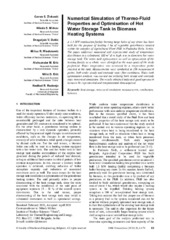Modeliranje strujno-termičkih procesa i optimizacija rada akumulatora toplote u grejnim sistemima sa toplovodnim kotlom na biomasu
Numerical simulation of thermo-fluid properties and optimization of hot water storage tank in biomass heating systems
| dc.creator | Živković, Goran | |
| dc.creator | Mirkov, Nikola | |
| dc.creator | Dakić, Dragoljub | |
| dc.creator | Mladenović, Milica R. | |
| dc.creator | Erić, Aleksandar M. | |
| dc.creator | Erić, Milić D. | |
| dc.creator | Rudonja, Nedžad | |
| dc.date.accessioned | 2022-09-19T16:25:45Z | |
| dc.date.available | 2022-09-19T16:25:45Z | |
| dc.date.issued | 2010 | |
| dc.identifier.issn | 1451-2092 | |
| dc.identifier.uri | https://machinery.mas.bg.ac.rs/handle/123456789/1033 | |
| dc.description.abstract | Za potrebe zagrevanja 1 ha plastenika na poljoprivrednom dobru u Padinskoj Skeli, koje se nalazi u okviru PKB korporacije, izgrađen je grejni sistem sa kotlom na biomasu, u kome se toplota dobija sagorevanjem balirane sojine slame. Zbog nestacionarnih efekata zagrevanja pojavila se potreba za uključivanjem akumulatora toplote u sistem grejanja. Ovaj rad ima za cilj numeričku i eksperimentalnu studiju izvršenu sa ciljem optimizacije akumulatora toplote u predmetnom grejnom sistemu, kao i optimizaciju celokupnog grejnog sistema. U akumulatoru toplote kapaciteta 100 m3, u kome se skladišti zagrejana voda, izvršena su merenja u 256 tačaka, kako u stacionarnom tako i u nestacionarnom režimu rada kotla. Analiza optimizacije je izvršena numeričkom simulacijom koja je obuhvatala i stacionarne i nestacionarne režime. Dobijeni rezultati pokazuju dobro poklapanje rezultata dobijenih eksperimentom i numeričkom simulacijom. | sr |
| dc.description.abstract | A 1.5 MW combustion facility burning large bales of soy straw has been built for the purpose of heating 1 ha of vegetable greenhouses located within the complex of Agricultural Plant PKB in Padinska Skela, Serbia. The paper addresses numerical and experimental study of temperature distribution in a cylindrical, 100 m3 (8 m high, 4 m in diameter) hot water storage tank. The water tank optimization, as well as optimization of the heating facility as a whole, were identified as the main goals of the study performed. Water temperature was measured by a temperature probe inserted in the tank. Measurements were conducted in 256 measurement points, both under steady and unsteady water flow conditions. Water tank optimization analysis was carried out utilizing both steady and unsteady state numerical simulation. The results obtained indicated good agreement between the experimental and computational data acquired. | en |
| dc.publisher | Univerzitet u Beogradu - Mašinski fakultet, Beograd | |
| dc.relation | info:eu-repo/grantAgreement/MESTD/MPN2006-2010/18035/RS// | |
| dc.rights | openAccess | |
| dc.rights.uri | https://creativecommons.org/licenses/by/4.0/ | |
| dc.source | FME Transactions | |
| dc.subject | numerical simulation | en |
| dc.subject | measurements | en |
| dc.subject | heat storage | en |
| dc.subject | combustion | en |
| dc.subject | biomass | en |
| dc.title | Modeliranje strujno-termičkih procesa i optimizacija rada akumulatora toplote u grejnim sistemima sa toplovodnim kotlom na biomasu | sr |
| dc.title | Numerical simulation of thermo-fluid properties and optimization of hot water storage tank in biomass heating systems | en |
| dc.type | article | |
| dc.rights.license | BY | |
| dc.citation.epage | 70 | |
| dc.citation.issue | 2 | |
| dc.citation.other | 38(2): 63-70 | |
| dc.citation.rank | M51 | |
| dc.citation.spage | 63 | |
| dc.citation.volume | 38 | |
| dc.identifier.fulltext | http://machinery.mas.bg.ac.rs/bitstream/id/18/1030.pdf | |
| dc.identifier.rcub | https://hdl.handle.net/21.15107/rcub_machinery_1033 | |
| dc.identifier.scopus | 2-s2.0-85047756622 | |
| dc.type.version | publishedVersion |


